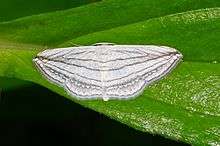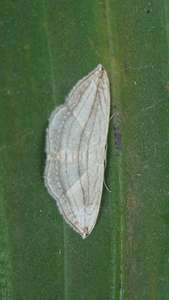Scopula opicata
Scopula opicata is a moth of the family Geometridae first described by Johan Christian Fabricius in 1798.[1] It is found in tropical Africa, including Malawi and Zambia,[2] as well as in Sri Lanka, India, China (Hainan), Myanmar, Sundaland, the Philippines, Sulawesi, Timor and New Guinea.[3]
| Scopula opicata | |
|---|---|
 | |
 | |
| Scientific classification | |
| Kingdom: | Animalia |
| Phylum: | Arthropoda |
| Class: | Insecta |
| Order: | Lepidoptera |
| Family: | Geometridae |
| Genus: | Scopula |
| Species: | S. opicata |
| Binomial name | |
| Scopula opicata (Fabricius, 1798) | |
| Synonyms | |
| |
Description
Its wingspan is 20 millimetres (0.79 in). The species is white slightly irrorated (sprinkled) with brown. Frons blackish. Abdomen with brown rings. Forewings with prominent oblique brown line from lower angle of cell to inner margin near base. Another line runs from apex to middle of inner margin. Three submarginal lines diverging from the apex, of which the outer two are slightly waved. A marginal line present. Hindwings with sub-basal, antemedial, and medial prominent lines. Two waved postmedial lines and a marginal line present.[4]
References
| Wikimedia Commons has media related to Scopula opicata. |
- Sihvonen, Pasi (April 1, 2005). "Phylogeny and classification of the Scopulini moths (Lepidoptera: Geometridae, Sterrhinae)". Zoological Journal of the Linnean Society. 143 (4): 473–530. doi:10.1111/j.1096-3642.2005.00153.x.
- De Prins, J. & De Prins, W. (2017). "Scopula opicata (Fabricius, 1798)". Afromoths. Retrieved March 29, 2018.
- "Scopula opicata Fabricius". The Moths of Borneo. Retrieved 2 October 2016.
- Hampson, G. F. (1892). The Fauna of British India, Including Ceylon and Burma: Moths Volume I. Taylor and Francis – via Biodiversity Heritage Library.